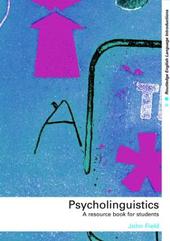
|
Psycholinguistics: A Resource Book for Students
Paperback
Main Details
| Title |
Psycholinguistics: A Resource Book for Students
|
| Authors and Contributors |
By (author) John Field
|
| Series | Routledge English Language Introductions |
|---|
| Physical Properties |
| Format:Paperback | | Pages:224 | | Dimensions(mm): Height 246,Width 174 |
|
| Category/Genre | Psycholinguistics |
|---|
| ISBN/Barcode |
9780415276009
|
| Classifications | Dewey:401.9 |
|---|
| Audience | | Tertiary Education (US: College) | | Professional & Vocational | |
|---|
| Illustrations |
15 black & white tables
|
|
Publishing Details |
| Publisher |
Taylor & Francis Ltd
|
| Imprint |
Routledge
|
| Publication Date |
6 February 2003 |
| Publication Country |
United Kingdom
|
Description
Psycholinguistics: covers the core areas of psycholinguistics: language as a human attribute, language and the brain, vocabulary storage and use, language and memory, the four skills (writing, reading, listening, speaking), comprehension, language impairment and deprivation draws on a range of real texts, data and examples, including a Radio Four interview and an essay written by a deaf writer provides classic readings by the key names in the discipline, including Aitchison, Deacon, Logie, Levelt and Bishop. Visit the accompanying website at www routledge.com/textbooks/0415276004
Author Biography
Kings College, London, UK
Reviews'For students new to the discipline, Psycholinguistics is a well-written and accessible introduction to the field.' 'The strength of the book is the guiding questions and the reading instructions provided in each section. These guidelines serve as discerning strategies for beginners to approach psycholinguistics.' - Jyh Wee Sew, Linguistische Berichte 'This book succeeds admirably in making the complex and diverse field of psycholinguistics clear and accessible, guiding readers through basic concepts and issues and then engaging them in more focused critical reflection... An invaluable resource for students which will foster their interest in the subject.' - Ema Ushioda, University of Warwick, UK 'An excellent introduction to the complex and sometimes bewildering field of psycholinguistics, covering the central issues in a way that is both comprehensive and accessible. In short, the book fills a real gap, and I will certainly be using it on the course I teach.' - Sushie Dobbinson, York St John College, UK
|